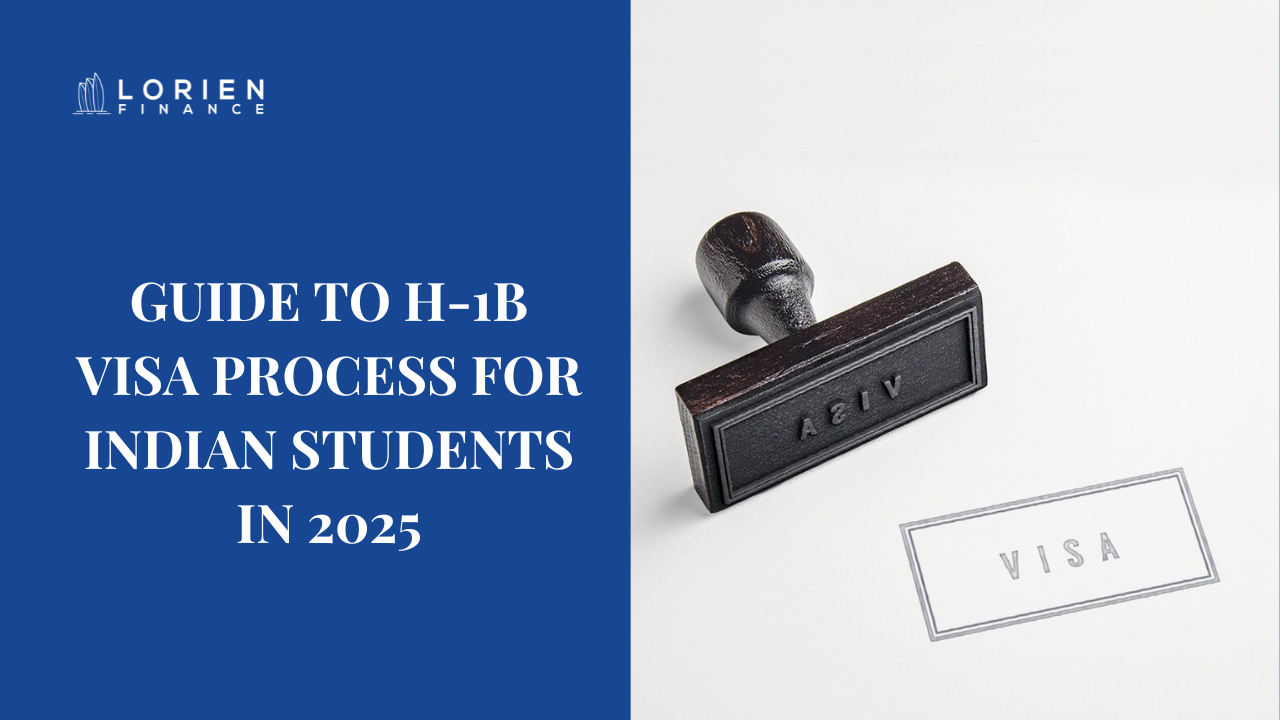No Collateral Education Loans for Indian Students: Pros and Cons

Every year, thousands of Indian students dream of studying abroad—but one major hurdle stops many in their tracks: financing. The biggest barrier? Collateral. Most traditional Indian banks require property or liquid security to issue a study abroad loan. But what if you don’t have that? Are your dreams over? Absolutely not. That’s where no collateral education loans for Indian students come in—offering students a chance to fund their education based on potential, not possessions. And at Lorien Finance, we’ve seen firsthand how these loans are transforming futures. What Are No Collateral Education Loans? A no collateral education loan (also known as an unsecured education loan) doesn’t require students or their families to pledge any property or assets. Almost all lenders—including Indian banks and NBFCs—offer unsecured loans today. However, here’s the catch: when there’s no collateral, interest rates are significantly higher, and the approval process is far more selective. The real game-changer comes when a lender offers no collateral and no cosigner loans—which is still rare. That’s where MPOWER Financing, Prodigy Finance, and Earnest stand out. These global lenders give eligible Indian students access to education funding based purely on academic potential, admission offer, and future income prospects—without requiring family backing or property. The Growing Trend: Why More Students Are Choosing No Collateral Loans Almost all students aspiring to study abroad Google this question multiple times “how to get an education loan without collateral or co-signer”. Many students shared struggles such as: “My family doesn’t own a home. No Indian bank will give me a loan.” “I have an admit from a top US university but can’t get funding because I don’t have property to pledge.” In fact, a recent Google Trends report showed a 34% YoY increase in searches for study abroad loans without collateral from Tier-2 and Tier-3 cities in India. This rise in demand is being met by lenders who believe in the future value of a student’s education. But is this type of loan right for everyone? Let’s break it down. Pros of No Collateral Education Loans The biggest advantage is clear—you don’t need to own a house, land, or have savings in the form of FDs to apply. This makes global education accessible to first-generation learners and students from modest backgrounds. These loans are assessed based on your university admit, academic performance, and future earning potential. This is perfect for high-potential students who may not have strong financial backing but do have bright futures. Many of these loans cover more than just tuition—they also cover living expenses, insurance, travel, and materials. This means you don’t have to scramble for partial funding. Unlike traditional banks that take weeks and multiple physical visits, lenders like MPOWER, Prodigy, and Earnest offer fast, paperless approvals. Some approvals are issued in under a week. All three lenders issue loan sanction letters valid for visa interviews, a major plus when applying to the U.S., Canada, or the UK. Cons of No Collateral Education Loans Because these are unsecured loans, the interest rates are typically 2–4% higher than secured loans. However, some lenders offer interest rate discounts for on-time payments and autopay enrollment. For example, MPOWER has a fixed interest rate of \~12–13% APR, with 0.5–1.5% discount options over time. Lenders often work with pre-approved universities or courses. If your admit isn’t on their list, you may not be eligible. Many no collateral lenders like Prodigy Finance only fund postgraduate (PG) programs, leaving undergraduate students with fewer options (except MPOWER, which funds both UG and PG). Loans from international lenders are disbursed and repaid in USD, EUR, or CAD. If you return to India post-graduation, exchange rate fluctuations can impact your repayment. Some lenders (like MPOWER) charge a 5% origination fee, which is deducted upfront. While this isn’t unusual, students should budget accordingly. Should You Choose a No Collateral Loan? Here’s the bottom line—if you don’t have collateral or a co-signer, a no collateral loan might be your only path forward. Yes, interest rates are higher, but so is the opportunity cost of not attending your dream university. What matters is getting the right fit. That’s where Lorien’s Study Abroad Loan Fest comes in. We bring all top lenders to the table—compare their rates, benefits, and timelines in one place. Your education is one of the best investments you’ll ever make. We know the loan process can feel overwhelming—but we’ve got your back. At Lorien Finance, we help you navigate your options, compare no collateral education loans, and apply with confidence. Whether you’re just starting out or stuck mid-way—we’re here to get you to the finish line. FAQs Is it safe to take a no collateral education loan from international lenders? Yes, if you’re applying through reputable lenders like MPOWER, Prodigy, or Earnest, the process is secure and legally regulated. How do I know if my university is eligible? Check each lender’s website or use Lorien’s free eligibility tool to see if your program is on their approved list. What happens if I return to India after studies? You’ll still repay in the loan currency (e.g., USD), so plan finances accordingly. Many students begin repayment once employed abroad to manage exchange rates better. Which is better: no collateral or with collateral loan? If you have property and want a lower interest rate, go with a secured loan. If not, no collateral loans are a strong alternative based on merit. Can I apply before my visa interview? Absolutely. A loan sanction letter from a lender is accepted as proof of funds during visa interviews.
Who Can Be a Co-Applicant for Study Abroad Loans?

Embarking on an international education journey is a dream for many Indian students. However, securing the necessary funding is a crucial step in this process. While getting an education loan comes up as the most opted solution, many lenders require you to have a co-applicant to secure the loan. At Lorien Finance, we understand the importance of having the right co-applicant for study abroad loans to strengthen your loan application and increase approval chances. The process of selecting a suitable co-applicant can significantly impact your study abroad financing journey. Whether you’re planning to study in the US, UK, Canada, or Australia, understanding who can be a co-applicant and how they affect your loan eligibility is crucial. A co-applicant for your education loan not only shares the responsibility of repayment but also strengthens the loan application by providing additional financial assurance to lenders. Let’s walk you through everything you need to know about co-applicants for study abroad loans, helping you make informed decisions about your education financing. What is a Co-Applicant for Study Abroad Loans? A co-applicant, often referred to as a co-borrower, is an individual who joins you (the primary applicant i.e. the student) in applying for an education loan. They share the responsibility of loan repayment and become legally obligated to repay the loan if the primary borrower fails to do so. For study abroad loans, co-applicants play a crucial role in strengthening the application by adding financial credibility and stability. Including a co-applicant can enhance the credibility of the loan application, potentially leading to better interest rates and higher loan amounts. Most financial institutions and lenders require a co-applicant for international education loans as a form of security, ensuring the loan will be repaid even if unforeseen circumstances arise. Who Can Be a Co-Applicant for Study Abroad Loans? Parents Parents are the most common and preferred co-applicants for study abroad loans. Most financial institutions and lenders prioritise applications where one or both parents serve as co-applicants. This preference stems from the natural financial responsibility parents typically assume for their children’s education. Both parents can jointly apply as co-applicants, which can further strengthen the application. If your parents have stable income sources, good credit scores, and sufficient assets, they make ideal co-applicants for your study abroad loan. Siblings In cases where parents cannot be co-applicants due to age restrictions or financial constraints, siblings can step in. However, for siblings to qualify as co-applicants, they must: Siblings who are well-established professionally can significantly enhance your loan application’s strength. Spouse For married students, spouses often serve as co-applicants for study abroad loans. A working spouse with a good credit history and stable income can be an excellent co-applicant. In fact, having a spouse as a co-applicant can be advantageous as it demonstrates shared financial responsibility and potentially higher combined income. If both you and your spouse are planning to study abroad together, you might want to explore scholarships and financial aid options to complement your education loan. Other Relatives Beyond immediate family members, certain lenders may accept other close relatives as co-applicants for study abroad loans. These may include: When considering relatives as co-applicants, it’s essential to verify the specific policies of your chosen lender, as not all financial institutions accept extended family members as co-applicants. Understanding different types of education loans available can help you identify which lenders might be more flexible with co-applicant requirements. Benefits of Having a Co-applicant Including a co-applicant in your education loan application offers several advantages: Eligibility Criteria for Co-Applicants Age Requirements Most lenders specify age limits for co-applicants. Typically, the co-applicant should be: These age restrictions ensure that the co-applicant is legally able to enter into a financial contract and is likely to remain employed throughout the loan tenure. Income and Employment Stability Co-applicants should demonstrate financial stability through: Lenders evaluate the co-applicant’s income to assess their ability to repay the loan in case the primary borrower defaults. Higher income stability translates to better chances of loan approval. Credit History and Score A co-applicant’s credit history significantly influences the loan application. Lenders prefer co-applicants with: Co-applicants with excellent credit histories can help secure better loan terms, including lower interest rates. Residential Status and Nationality For Indian students seeking study abroad loans: Special Considerations for Who Can Be a Co-Applicant Single Parent Scenarios For students from single-parent households, most lenders accept the single parent as the sole co-applicant. In such cases, the financial assessment focuses entirely on the single parent’s credentials. Some lenders might allow another close relative to join as a second co-applicant to strengthen the application. Self-Sponsored Students Mature students or those with work experience might apply as self-sponsored applicants. However, most lenders still require a co-applicant for international education loans regardless of the student’s financial status. The co-applicant requirement may be relaxed only in exceptional cases where the student has substantial assets or an exceptionally strong financial profile. Government-Backed Loan Schemes Government-sponsored education loan schemes like the Vidya Lakshmi portal may have different co-applicant requirements. These schemes often have more flexible criteria and might accept a wider range of co-applicants or have different eligibility parameters altogether. Comparing Co-Applicant Requirements Across Lenders Different lenders have varying policies regarding who can be a co-applicant for study abroad loans. During our Loan Fest, you’ll get an opportunity to directly compare these requirements across multiple lenders. Here’s a general overview: Traditional Banks NBFCs and Specialised Education Loan Providers International Financial Institutions Study Abroad Loan Fest Why chase lenders individually when they can all come to you? That’s the idea behind Lorien Finance’s Loan Fest – India’s biggest abroad education loan event where you can compare multiple public and private lenders for your study abroad loan. At our Loan Fest, you can secure your loan for your abroad studies at interest rates starting at 3.39%* from 17+ Indian and International lenders. There’s more! You can even enjoy exclusive benefits, including assured gifts worth ₹2,000 on successful loan disbursement and rewards like MacBook, iPhones and study abroad travel kits
Forex Tips for Indian Students Abroad in 2025

If you’re an Indian student planning to study abroad in 2025, managing your finances efficiently is crucial – especially when it comes to foreign exchange. With fluctuating currency rates and various transaction options available, navigating the forex landscape can be overwhelming. At Lorien Finance, we’ve guided thousands of students through their international education journey, and we understand that smart forex tips for Indian students abroad can save you significant money throughout your academic adventure. The forex needs of international students extend beyond just currency conversion. From tuition payments and accommodation expenses to daily living costs and emergency funds, having the right forex strategy in place ensures you’re not losing money on excessive fees or unfavourable exchange rates. Let’s dive into practical forex tips for Indian students abroad in 2025, so that you make informed decisions about managing your foreign currency needs. Planning Your Forex Strategy in Advance Starting your forex planning at least 3-4 months before departure gives you time to: Many students make the mistake of waiting until the last minute to convert their currency, often resulting in rushed decisions and acceptance of whatever rates are available at that moment. Leveraging Lorien Finance’s Flywire Partnership for Hassle-Free Transfers At Lorien Finance, we understand that transferring large sums for tuition and living expenses can be stressful. That’s why we’ve partnered with Flywire, a leading global payment solution provider specialising in cross-border transactions for education. This partnership offers our students several advantages when managing their forex needs: Through our forex services, students can conveniently manage their international payments while enjoying preferential rates negotiated through our institutional partnerships. This removes the hassle of searching for reliable forex dealers or worrying about hidden charges. Forex Tips for Indian Students Abroad: Destination-Specific Strategies United States and Canada For students heading to America, consider: UK and Europe If you’re studying in the UK or Europe, consider: Australia and New Zealand Students heading down under should: Digital Banking Solutions for Students Studying Abroad As we move further into 2025, digital banking options have become increasingly important for students going abroad. Consider these digital solutions: Remember to verify that these digital services are compliant with both Indian regulations (particularly FEMA guidelines) and the regulations of your destination country. Essential Forex Tips for Indian Students Abroad: Avoiding Common Pitfalls Many students fall into these common traps when handling foreign exchange: Banks and exchange services often advertise “zero commission” but make money through marked-up exchange rates. Always calculate the effective exchange rate by comparing the amount you’ll receive against the mid-market rate available on financial websites. While having some cash in the local currency is advisable when you first arrive, carrying large amounts is both risky and inefficient. Most countries have strict declaration requirements for cash exceeding certain limits (typically around $10,000 or equivalent). Many universities have partnerships with local banks offering special student accounts with reduced fees and international transfer benefits. Research these options before departure and include them in your financial planning. Timing Your Forex Transactions Strategically For students going abroad, timing your foreign exchange transactions can significantly impact your overall education costs. Consider: Tax Implications and Compliance Requirements When transferring money abroad for education purposes, be aware of these regulatory aspects: At Lorien Finance, our education loan services include guidance on these compliance requirements, ensuring your transfers are processed smoothly and in accordance with regulations. Study Abroad Loan Fest Why chase lenders individually when they can all come to you? That’s the idea behind Lorien Finance’s Loan Fest – India’s biggest abroad education loan event where you can compare multiple public and private lenders for your study abroad loan. At our Loan Fest, you can secure your loan for your abroad studies at interest rates starting at 3.39%* from 17+ Indian and International lenders. There’s more! You can even enjoy exclusive benefits, including assured gifts worth ₹2,000 on successful loan disbursement and rewards like MacBook, iPhones and study abroad travel kits worth Rs. 20,000. Managing your forex needs efficiently is a crucial aspect of your study abroad journey. By planning ahead, leveraging Lorien Finance’s partnership with Flywire, understanding destination-specific considerations, and utilising digital solutions, you can minimize unnecessary expenses and protect yourself from adverse currency movements. Remember that your forex strategy should be integrated with your overall education financing plan. Whether you’re self-financing your education or taking an education loan, the way you handle foreign exchange can significantly impact your total education cost. For personalized guidance on creating a forex strategy tailored to your specific study abroad plans, connect with our advisors at Lorien Finance. FAQs How much foreign currency can I take with me when going abroad for studies?Under the Liberalised Remittance Scheme (LRS), Indian residents can remit up to $250,000 per financial year for education purposes. However, carrying large amounts of physical cash is not recommended. Most countries have restrictions on bringing in cash amounts over $10,000 or equivalent without declaration. When is the best time to convert INR to foreign currency for my studies?There’s no one-size-fits-all answer, as currency markets fluctuate based on numerous factors. However, it’s advisable to track exchange rates 3-4 months before your departure and consider splitting your conversions into multiple transactions to average out rates. Do I need any special documentation for transferring money abroad for education?Yes, for education-related remittances, you’ll typically need to provide your university admission letter, loan approval documentation (if applicable), Form A2, and sometimes Forms 15CA/15CB for larger amounts. Through Lorien Finance’s forex services, we guide you through the specific documentation required. How can I save on recurring transfers for living expenses while studying abroad?Consider opening a multi-currency account, using student-specific forex services, or setting up a local bank account in your destination country with favourable international transfer terms. Regular small transfers often incur higher cumulative fees than fewer, larger transfers. Will my Indian debit/credit cards work abroad, and what fees should I expect?Most Indian cards work internationally, but they typically charge foreign transaction fees (2-4%) plus currency conversion markups. Some banks offer student-specific cards with
Public vs Private Lenders: The Right Choice for Study Abroad Loan

Packing your bags for a foreign university? Exciting times ahead! But let’s talk about that elephant in the room – the finances. Between sky-high tuition fees and living costs in another country, the numbers can make your head spin. That’s where study abroad loan come to the rescue for countless Indian students pursuing global education dreams. But here’s the million-dollar question (quite literally): should you go with public or private lenders for your education funding? At Lorien Finance, we’ve guided thousands of students through this exact dilemma. Trust us, we’ve seen the confusion in students’ eyes when they’re bombarded with loan jargon, fluctuating interest rates, and complex repayment structures. This guide helps you understand which type of lender might work best for your unique situation – because your study abroad loan is not just a financial product, it’s the base of your international education journey. Understanding Public Sector Banks for Study Abroad Loans Remember those imposing bank buildings with long queues and lots of paperwork? Those public sector banks, backed by government funds, have been the go-to option for generations of Indian students. They follow specific guidelines under schemes like the Model Education Loan Scheme and operate through platforms like the Vidya Lakshmi Portal. Key Features of Public Sector Bank Loans Meet our Public Banks Partners Lorien Finance has established strong partnerships with leading public sector banks in India to offer competitive study abroad loan options: State Bank of India (SBI): Not just India’s largest bank – it’s practically an institution! SBI’s global presence makes life easier with education loans starting at 8.65% interest and funding up to ₹1.5 crore. Their staff understands international education nuances, having helped generations of overseas students. Perfect if you’re headed to popular destinations like the US, UK, or Australia. Union Bank of India (UBI): Their “Union Education” scheme deserves attention, especially for female students who enjoy special interest rate concessions. What we love about UBI is their flexibility with repayment – up to 15 years to clear your loan means lower monthly payments when you’re starting your career. They’ve recently streamlined their documentation requirements too. Punjab National Bank (PNB): High academic achievers, PNB might be your best friend! Their “PNB Pratibha” scheme offers additional benefits if you’ve scored well in your previous academics. Their partial collateral options for mid-range loan amounts have helped many students from tier-2 cities realise their study abroad dreams despite limited property assets. Limitations of Public Sector Banks While public banks offer several advantages, they come with certain limitations: Understanding Private Lenders for Study Abroad Loans The private lending landscape has transformed dramatically in recent years, with specialised education loan providers and private banks creating products specifically designed for international students. These lenders have recognised the unique challenges of education loan for international students and adapted accordingly. Advantages of Private Lenders for Education Loan for International Students Private Lenders in Lorien Finance’s Network We’ve partnered with India’s top private financial institutions to provide diverse financing options: Avanse Financial Services: These education financing specialists get it – they understand why your specific course in Canada costs what it does. Their quick 10-day processing time has saved countless admission offers. Their staff actually knows the difference between an MS and an MBA requirement, making the experience notably smoother. Axis Bank: Beyond just lending money, their Global Ed-vantage program offers practical tools like forex cards and global accounts that simplify life abroad. Their relationship managers often have international education backgrounds themselves – the advice goes beyond just financing. ICICI Bank: Their extensive international banking network means you can easily handle repayments from almost anywhere in the world. Their pre-approved loan offers for students admitted to top-tier universities can fast-track your application considerably. Credila: India’s first dedicated education loan company understands that every study plan is unique. Their famous 100% financing option covers both tuition and living expenses without requiring upfront contributions from families – a major relief for many parents stretching their savings. IDFC First Bank: Their digital-first approach means less running around with papers and more online processing. Their extended moratorium periods are particularly helpful for longer programs like PhDs or medical courses where earning potential is delayed. Auxilo: This specialised education NBFC offers course-and-country-specific loan packages. Their minimal documentation approach for premier institutions means less paperwork headaches. They’re particularly good with professional courses like law and medicine. InCred: Their technology-driven approach evaluates future potential alongside traditional criteria. Their part-disbursement facility means you receive funds exactly when needed rather than managing a large sum upfront. Their special consideration for students with unconventional academic backgrounds opens doors for many. Tata Capital: Their “No Collateral” education loan option for premier institutions has unlocked opportunities for bright students from middle-class backgrounds. Their transparent fee structure means no hidden surprises down the road. Limitations of Private Sector Lenders Despite their advantages, private lenders have certain aspects to consider: Finding Your Perfect Study Abroad Loan Match Every student’s situation is unique – there’s no one-size-fits-all answer to the public vs. private debate. Consider these factors: Let’s be honest – loans for Harvard are easier to get than for lesser-known universities, regardless of lender type. However, private lenders might be more flexible with up-and-coming institutions that public banks haven’t yet added to their “approved” lists. Need ₹60 lakhs for that dream MBA? Private lenders might be your only option, despite the higher interest rates. Public banks may fall short for programs with premium price tags, making affordable study abroad financing options from private lenders necessary despite the higher costs. Got admission last-minute or facing tight deadlines? Private lenders’ quick education loan approval process might be worth the extra interest cost. When universities need confirmation within weeks, processing time becomes more important than interest rates. No property papers to show? Several private lenders offer education loan without property collateral options that might be your pathway forward. For families with limited assets but strong academic profiles, these specialised programs open doors that traditional banking cannot. Study Abroad Loan Fest
Guide to H-1B Visa Process for Indian Students in 2025

Are you excited about studying in the USA and building an amazing career afterward? Many Indian students share this dream every year, with thousands applying to American universities. Understanding the H-1B visa process for Indian students in 2025 is essential if you want to turn your US education into long-term employment opportunities. With Donald Trump’s return to the White House, the H-1B visa process for Indian students has seen some important updates in 2025. This guide breaks down everything you need to know – from eligibility requirements and application steps to strategic tips that can help boost your chances of success. Whether you’re just starting your US education journey or approaching graduation, these insights will help you navigate the path to working legally in America. What is an H-1B Visa for Indian Students? The H-1B visa is a non-immigrant work permit that allows US companies to hire foreign workers for specialised jobs. For Indian students who have completed their American education, the H-1B visa process is the most common pathway to legal employment in the United States. Key Changes to H-1B Visa Process for Indian Students in 2025 Several important updates have been implemented this year: H-1B Visa Eligibility for Indian Students To qualify for the H-1B visa process in 2025, you must have: How the H-1B Visa Process Works for Indian Students in 2025 Strategic Tips for Indian Students Pursuing H-1B Visas Alternative Pathways to Working in the US If the H-1B visa process doesn’t work out immediately: How Lorien’s Study Abroad Loan Fest Can Help You Secure Your US Education Loan Now that you’re well-informed about the H-1B visa process in 2025, it’s crucial to address a major part of your US journey—securing financial backing. Without strong financial proof, even the best visa applications can stumble. That’s precisely where Lorien Finance’s Study Abroad Loan Fest can make all the difference. Whether you’re awaiting university admits or holding your I-20 form, securing your education loan early significantly enhances your visa application. Lorien’s Loan Fest is specifically tailored for ambitious students seeking reliable financial backing for their US education. What is the Study Abroad Loan Fest? Lorien Finance’s limited-time initiative connects you directly with top education loan providers, offering personalised expert guidance for faster and smarter loan approvals. How Lorien Helps: Why Lorien Matters for Your US Visa Visa officers prioritise robust financial backing in visa approvals. With Lorien’s support, you’ll confidently approach your interview equipped with sanctioned loans and comprehensive documentation. Whether at the beginning of your application process or days away from your visa interview, Lorien’s Study Abroad Loan Fest is your best companion. Act now, secure your education loan seamlessly, boost your visa approval prospects, and join your dream university stress-free! FAQs Can I apply for the H-1B visa during my OPT period? Yes, many Indian students transition from OPT to H-1B. Coordinate with your employer on timing. What happens if my petition isn’t selected in the lottery? You can continue on OPT if eligible and apply again next year. How long can I stay in the US with an H-1B visa? Initially three years, extendable to six years total. Longer extensions possible when pursuing permanent residency. Can I change employers while on H-1B status? Yes, but your new employer must file a petition for you.
US Work Opportunities for International Students 2025

Thinking about studying in America and launching your career there afterward? You’re just like thousands of other Indian students in their early twenties! Many young people are drawn to US work opportunities in 2025 because they offer amazing career paths, global connections, and the chance to build professional networks that last a lifetime. Understanding how to take advantage of these US work opportunities is essential if you want to transform your academic journey into career success. The landscape has shifted considerably in 2025, with new immigration rules and employment regulations changing how international students plan their professional journeys in America. This guide breaks down everything from internships through Curricular Practical Training (CPT) to maximising your Optional Practical Training (OPT) and ultimately securing that coveted H-1B visa. We’ll walk you through the practical steps to thrive in the competitive world of US work opportunities in 2025. Understanding OPT and CPT: Essential US Work Opportunities in 2025 Optional Practical Training (OPT) remains a vital pathway for international students, providing up to 12 months of work authorisation after graduation. If you’re in a STEM field, you get an extra bonus – a 24-month extension! However, the rules have tightened in 2025. Both you and your employer now need to provide detailed documentation showing how your job directly relates to what you studied. Curricular Practical Training (CPT) hasn’t changed as much, but it’s still crucial for gaining work experience during your studies. Universities in 2025 must clearly show how each internship fits into your degree program. This ensures your practical experience genuinely complements what you’re learning in class. Navigating H-1B Visas to Secure Long-Term US Work Opportunities Landing an H-1B visa remains the big goal for most graduates hoping to build careers in America. But competition for these US work opportunities in 2025 has become fiercer than ever. Companies now prioritise candidates with higher salaries and advanced degrees from American universities. With only 85,000 visas available each year, proper planning makes all the difference. We’ve seen so many students succeed by starting their H-1B preparations early – networking with potential employers already in their second semester and targeting companies with strong track records of sponsoring international graduates. One classmate secured her position six months before graduation by demonstrating specialised skills that were hard to find locally. Hot Fields for US Work Opportunities in 2025 Some industries are especially welcoming to international talent right now: Alternative Countries with Strong Work Opportunities in 2025 Given how competitive US work opportunities can be in 2025, many students are considering other appealing options: Smart Strategies to Secure US Work Opportunities in 2025 Based on our research and conversations with successful international graduates, here are practical tips: How Lorien’s Study Abroad Loan Fest Can Help You Secure Your US Education Loan Now that you’re well-informed about the H-1B visa process in 2025, it’s crucial to address a major part of your US journey—securing financial backing. Without strong financial proof, even the best visa applications can stumble. That’s precisely where Lorien Finance’s Study Abroad Loan Fest can make all the difference. Whether you’re awaiting university admits or holding your I-20 form, securing your education loan early significantly enhances your visa application. Lorien’s Loan Fest is specifically tailored for ambitious students seeking reliable financial backing for their US education. What is the Study Abroad Loan Fest? Lorien Finance’s limited-time initiative connects you directly with top education loan providers, offering personalised expert guidance for faster and smarter loan approvals. How Lorien Helps: Why Lorien Matters for Your US Visa Visa officers prioritise robust financial backing in visa approvals. With Lorien’s support, you’ll confidently approach your interview equipped with sanctioned loans and comprehensive documentation. Whether at the beginning of your application process or days away from your visa interview, Lorien’s Study Abroad Loan Fest is your best companion. Act now, secure your education loan seamlessly, boost your visa approval prospects, and join your dream university stress-free! FAQs When should I apply for OPT? You can apply up to 90 days before finishing your program. I suggest applying as early as possible – my application took almost 80 days to process last year. Can I change jobs during OPT? Yes! As long as your new job relates to your field of study and you update your information in SEVIS promptly. A friend switched from a small startup to Google during her OPT without any issues. Which fields have the best H-1B chances in 2025? Technology, finance, healthcare, and engineering remain the most competitive due to high demand and specialised skill requirements. Are CPT internships always paid? No – they can be paid or unpaid, but they must directly relate to your courses. My unpaid CPT at a nonprofit actually led to a full-time job offer later. How long does H-1B approval usually take? Typically a few months, though premium processing (for an extra fee) can speed things up to about 15 days. My employer covered the premium processing fee, and we had an answer in just 12 days.
Visa Denied? Key Student Loan Tips for Visa Success

Every year, thousands of students dream of studying abroad, excited to embrace new cultures, gain world-class education, and build a promising future. But amidst the excitement, there’s one problem that can unexpectedly put an end to all these plans — a visa denial. What many students don’t realise is that student loan tips for visa success can make a crucial difference in securing that much-needed visa. If you’re planning your abroad education, understanding the connection between student loans and visa success is essential. Let’s break it down and help you avoid common pitfalls, so your study abroad dream stays on track. Understanding the Visa-Lending Connection When assessing your student visa application, authorities want to ensure you have the financial stability to support yourself during your studies. This is where your education loan becomes more than just a financial tool — it becomes a statement of your preparedness. A well-structured loan from a recognised lender shows that your education and living expenses are accounted for, giving visa officers confidence in your ability to fund your studies without needing to work illegally or face financial hardship. But there are key factors that can make or break this process. Student Loan Tips for Visa Success Not all education loans are created equal. Opt for a loan specifically designed for studying abroad rather than a personal loan. Education loans offer better interest rates, tailored repayment plans, and official documentation that visa authorities expect. One of the most common reasons for visa delays or denials is incomplete paperwork. When securing your loan, make sure you receive a Sanction Letter from the lender. This letter acts as official proof of funds and must be included in your visa application. Visa authorities prefer loans from reputed financial institutions. Partnering with trusted lenders gives your application more credibility. Through Lorien Finance’s network of 17+ verified lenders, students can access loans that meet these expectations. Taking a loan amount that accurately reflects your tuition fees, living expenses, and other costs is key. Over-borrowing can raise red flags, while under-borrowing can signal insufficient funds. Tools like Lorien Finance’s loan calculators can help determine the right amount. Visa officers want to know you have a plan for repaying your loan. Showcasing a structured repayment strategy demonstrates responsibility and reduces perceived risk. How Lorien Finance Helps With Student Loan Tips for Visa Success? At Lorien Finance, we understand that your education loan is more than just a means to fund your studies; it’s a stepping stone toward securing your visa and building your future. Through India’s biggest Study Abroad Loan Fest, we’re making this journey smoother and more rewarding. Here’s what students gain by choosing Lorien Finance: Securing your student visa can be overwhelming, but the right loan partner can make all the difference. By following these tips and choosing a reliable partner like Lorien Finance, you’re not just securing a loan — you’re building a strong foundation for your study abroad dreams. Ready to take the next step? Explore India’s most rewarding Study Abroad Loan Fest with Lorien Finance. FAQs Can a loan rejection affect my visa application? Yes, a rejected loan application can signal financial instability to visa officers, impacting your chances. Do visa officers prefer loans from specific lenders? Visa officers look for loans from recognised financial institutions, as they indicate credible financial backing. What if I need more funds later? Some lenders offer top-up loans. Lorien Finance helps students find flexible lenders who accommodate such needs. How do I apply for Lorien Finance’s Study Abroad Loan Fest? Visit Lorien Finance’s website, fill out the application form, and get connected with trusted lenders offering the best rates and exciting rewards.
Transparent Education Loans: No Hidden Fees, No Surprises

No hidden fees, no surprises — isn’t that what all of us dream of when applying for transparent education loans to study abroad? Unfortunately, the reality is pretty different. Complicated terms, unexpected charges, and confusing agreements can turn what seemed like a simple financial solution into a stressful experience. But does it have to be this way? Transparent education loans make sure you know exactly what you’re signing up for — with clear interest rates, straightforward repayment terms, and no unpleasant surprises along the way. Let’s dive into why transparency matters and how it can make your study abroad journey smoother. The Importance of Transparent Education Loans Transparent education loans are characterised by clear, straightforward terms that are easily understood by borrowers. This clarity is vital, especially for international students who may already be navigating unfamiliar financial landscapes. Understanding loan terms such as interest rates, repayment schedules, and any associated fees is crucial to avoid unexpected financial burdens during or after your studies. Key Elements of Transparent Education Loans The Risks of Confusing Loan Agreements Engaging with lenders who do not provide clear loan terms can lead to several challenges: How to Identify Transparent Loan Providers? To ensure you choose a transparent loan provider, consider the following steps: Lorien Finance’s Study Abroad Loan Fest: Empowering Your Educational Journey At Lorien Finance, we understand the aspirations and challenges of students aiming to study abroad. Our commitment to transparency ensures that you receive clear and comprehensive information about our loan products. This commitment is clear in our ongoing Study Abroad Loan Fest, designed to make your educational financing seamless and rewarding. Highlights of the Study Abroad Loan Fest: Securing transparent education loans is a pivotal step in your study abroad journey. It ensures that your financial foundation is solid, allowing you to focus on achieving academic excellence and embracing new experiences. At Lorien Finance, through initiatives like the Study Abroad Loan Fest, we are dedicated to providing the clarity and support you need to turn your educational dreams into reality. FAQs What are transparent education loans? Transparent education loans are those where all terms and conditions, including interest rates, fees, and repayment schedules, are clearly communicated to the borrower, eliminating hidden clauses or unexpected charges. Why is transparency important in education loans? Transparency ensures that borrowers fully understand their financial commitments, preventing unforeseen expenses and allowing for better financial planning during and after their studies. How can I ensure a loan is transparent? To ensure transparency, thoroughly read the loan agreement, ask the lender for clarification on any unclear terms, and seek advice from financial advisors or mentors. How does Lorien Finance ensure transparency in its loans? Lorien Finance provides clear and detailed information about all loan terms, offers personalised financial guidance, and maintains open communication to address any borrower queries, ensuring a transparent lending process.
The Study Abroad Loan Hack: How Smart Students Save Big

Want to unlock the ultimate study abroad loan hack and save lakhs on your education loan? Smart students know that getting the right loan isn’t just about borrowing money — it’s about borrowing smart. Don’t fall into common traps that could cost you a fortune. In this guide, we’ll reveal the top study abroad loan hacks to help you secure the best education loan, avoid hidden fees, and set yourself up for financial success. Let’s dive in! Study Abroad Loan Hack #1: Compare, Compare, Compare! (Don’t Settle for the First Offer) Many students blindly take the first loan offered by their bank — without checking if there’s a better deal out there. That’s like booking the first flight you see without checking for discounts! You could be losing lakhs just because you didn’t compare options. How Smart Students Save Big? Study Abroad Loan Hack #2: Avoid the Forex Trap (Save on Hidden Exchange Fees!) Did you know that banks secretly charge an extra 2–5% in forex markup fees every time they convert INR to USD, GBP, EUR, or AUD? Let’s put that into perspective — on a ₹40 lakh loan, that’s an extra ₹80,000 to ₹2 lakh gone — just in currency conversion fees! How Smart Students Save Big? Study Abroad Loan Hack #3: Choose the Right Repayment Plan (Avoid Getting Stuck!) Most students don’t realise that not all loans have the same repayment structure. Some force you to start paying immediately, while others offer a grace period after graduation. Choosing the wrong plan could mean struggling with EMIs while still in university. Why pay early if you don’t have to? How Smart Students Save Big? Study Abroad Loan Hack #4: Skip the Collateral Hassle (Yes, It’s Possible!) Many traditional banks force students to pledge collateral (property, fixed deposits, etc.) before approving a loan. But what if you don’t have collateral? Should your dreams be put on hold? Absolutely not! How Smart Students Save Big? Study Abroad Loan Hack #5: Act Fast — Before the Best Loan Offers Disappear! Interest rates change frequently, and the best loan offers are available for a limited time. Many students wait too long, only to find out that the low-interest rates they saw last month are no longer available. How Smart Students Save Big? How Lorien Finance Helps You Save Lakhs on Your Study Abroad Loan? At Lorien Finance, we believe your education loan should be a stepping stone, not a financial burden. That’s why we help students like you secure the best loan deals — without the stress. Why Smart Students Choose Lorien Finance? The smartest students make the smartest financial decisions. Don’t overpay — secure your best loan today! FAQs Can I switch my loan if I already applied elsewhere? Yes! If you find a better deal with Lorien Finance, we can help you switch lenders and save big! Do I need a co-signer for my education loan? Not always! Lorien Finance offers co-signer-free loan options for eligible students. How fast can I get my loan approved? Lorien Finance can help you secure loan approvals in just a few days — much faster than banks. Will I have to pay prepayment penalties? No! Lorien Finance helps you find lenders with zero foreclosure fees, so you can repay anytime. Is there a processing fee? Many banks and NBFCs charge high processing fees. With Lorien Finance, you get access to lenders with the lowest fees in the industry.
How to Get a Powerful Scholarship Recommendation Letter: A Student’s Guide

So, you’re applying for a scholarship? That’s awesome! But hold on—before you start daydreaming about your new life abroad, there’s one major thing standing between you and that scholarship: a scholarship recommendation letter. Imagine this: You’ve worked hard, maintained great grades, participated in extracurriculars, and even written a killer scholarship essay. But so have thousands of other students. So, how do you prove that you deserve that financial aid more than anyone else? The answer lies in a well-written scholarship recommendation letter—one that speaks volumes about your academic excellence, leadership skills, and future potential. A recommendation letter is not just another document in your application; it’s a game-changer. It gives the scholarship committee a third-person perspective on your achievements, making your application more credible and compelling. Think of it as a letter of endorsement from someone who truly believes in you—a professor, mentor, or employer who has seen your dedication firsthand. If the thought of asking someone to write one makes you nervous, don’t stress! This guide will show you exactly how to get a strong, impactful scholarship recommendation letter that makes the committee say, “We need to give this student a scholarship!” Why is a Recommendation Letter So Important? A scholarship recommendation letter is more than just a formality—it’s your golden ticket to standing out. While your grades and application essays show what you think about yourself, a recommendation letter tells the committee what someone else thinks about you. Think of it like this: If you were applying for a job, would you believe someone who says, “I’m amazing at this,” or someone else saying, “This person is truly amazing at this”? That’s the power of a recommendation letter—it’s a credible endorsement of your abilities, character, and potential. Who Should You Ask for a Recommendation Letter? Not just anyone! The right person makes all the difference. Here’s who you should consider: Avoid asking: distant relatives, family friends, or someone who barely knows you. Their recommendation won’t have any depth! How to Ask for a Recommendation Letter (Without Making It Awkward!) Example message: Subject: Request for Scholarship Recommendation Letter Dear [Professor/Mentor’s Name], I hope you’re doing well! I am applying for [Scholarship Name], which requires a recommendation letter, and I immediately thought of you. Your guidance in [specific subject/activity] has played a huge role in my academic journey, and I would truly appreciate it if you could write a letter supporting my application. The deadline is [date], and I’d be happy to provide any details or documents that would help. Please let me know if this would be possible! Thank you so much for your time and support. Best regards, [Your Name] What Makes a Strong Recommendation Letter? A great recommendation letter isn’t just about saying nice things—it should be specific, personalised, and aligned with the scholarship’s goals. Here’s what it should include: Scholarship Recommendation Letter Template Here’s an example of what a great letter looks like: [Recommender’s Name] [Their Position] [School/Company Name] [Email Address] [Date] To the Scholarship Committee, I am honoured to recommend [Your Name] for the [Scholarship Name]. I have had the pleasure of teaching/mentoring [Your Name] for [X years], and I can confidently say that they are one of the most [positive quality] students I have worked with. [Your Name] has consistently demonstrated [specific skills or qualities]. For example, during [mention a project or achievement], they [explain how they excelled]. Their ability to [another key strength] sets them apart from their peers. Beyond academics, [Your Name] is an active member of [mention extracurriculars, leadership roles, or community work], showcasing their well-roundedness and dedication. Their work in [specific area] directly aligns with the values and objectives of this scholarship. I strongly believe that [Your Name] will make the most of this opportunity and continue to excel in their academic and professional pursuits. Please feel free to contact me if you require further information. Sincerely, [Recommender’s Name] How Lorien Finance Can Help You Study Abroad? We get it—studying abroad is exciting but expensive. That’s where Lorien Finance comes in. We make it easier for students like you to finance their dreams with: Don’t let finances hold you back! Let Lorien Finance help you fund your global education journey. Now that you know how to get a killer scholarship recommendation letter, go ahead and secure that scholarship! And if you need financial support for your study abroad journey, Lorien Finance has got your back. Apply for your Education Loan now! FAQs Can I ask multiple people for recommendation letters? Yes! Some scholarships require more than one letter. Just make sure each recommender highlights a different strength of yours. How long should the letter be? Ideally one page, but not more than two pages. What happens if my recommender misses the deadline? Follow up before the deadline, and have a backup recommender in case they are unable to submit on time.
